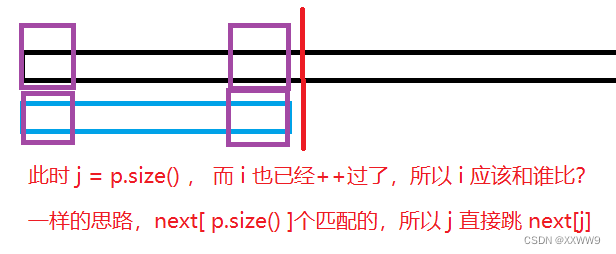Acwing算法基础课第二讲——数据结构
模拟单链表
方法:两个数组,一个存该索引位置的 val , 另一个存该索引位置的下一位置(即下一个位置的索引是啥)。
其中,第0号位置仅表示 链表的 head,不进行使用。
#include 模拟双向链表
思路同模拟单链表,只是这里需要两个数组来存指针,并且在删点、加点的操作上有些许区别。
双链表把数组的0位置作head,1e5+3位置 ( 其实可以随意 ) 作tail。
#include 模拟栈
这里我把栈写成了一个 类 ,可能和STL没什么区别,但这里是直接开一个很大的数组,在数组上进行操作,时间上应该会更快一点。
#include 模拟队列
模拟队列的缺陷就在于,当从队头pop元素后,那么这个数组的这部分就永远不会再被使用,如果操作过多,到最后队列的空间就会变成0。
解决方式是,把数组写成循环的。(还没写…)
#include 单调栈问题
单调栈是用来求数组中,离第 i 个数最近并大于 / 小于它的数。如[1 3 2],离 2 最近的小于2的是1。
单调栈用一个栈来维护一个递减 / 递增序列。
如[3 4 2 7 5],
初始时,栈为空,则比3小的为-1,然后3入栈 【3】
3比4小,则比4小的就是3,然后4入栈 【3 4】
4比2大,弹出,3比2大,弹出,没了,那就是-1,然后2入栈 【2】,这里一直弹出是因为,现在来了一个更小的,那么在后续的遍历过程中,前面的3、4都没用了,因为2比他们更小。
直到结束
#include 单调双端队列 / 滑动窗口问题
单调双端队列 能解决一个滑动窗口内 最大 / 小 值的问题。
#include KMP 字符串匹配问题
现有一个目标字符串 s 和 模式串 p, 找s中是否存在子串p,并返回位置。
正常暴力做法的时间复杂度是 O ( N 2 ) O(N^2) O(N2),通过KMP方法可以将复杂度降低到 O ( N ) O(N) O(N)。
KMP算法是通过维护模式串 p 的一个next数组,来实现对匹配过程的加速,相当于利用上了之前的匹配信息。
以 s = aaaaaaaaaab p = aaab 为例:
next数组维护的是,p中第 i 为之前的最大前后缀匹配长度,其中对next数组,人为规定next[0] = -1 , next[1] = 0;
最大前后缀匹配长度指的是,使前k个字符的子串 和 后k个字符的子串 相等 的最大k值。如 abab,前缀2为ab,后缀2为ab,前缀3为aba,后缀3为bab,所以abab的最大前后缀匹配长度为2。
所以next[i] 表示的就是0 ~ i - 1 的子串 的最大前后缀匹配长度。
那么next数组有什么用呢?

如何快速求 next 数组:
如果暴力地求next数组,时间复杂度还是很高的—— O ( N 2 ) O(N^2) O(N2)。

代码中是输出所有的匹配字符串,这和 找到一个匹配的就break有略微不同。
只要区别在:
1、求模式串p 的next数组时,多求一次,把next[ p.size() ] 也求出来,表示整个串 p 的最大前后匹配长度。
2、见程序kmp函数while循环的最后一行。如果 j == p.size(), 说明已经匹配完了,push结果,同时,我们就可以通过
next[ p.size() ]来快速定位到待匹配字符。

#include Trie树 / 前缀树
这个的思路我是按照牛客算法班的思路来写的。 没有考虑内存的释放问题,只开new数组,不管释放。
并且,如果把Trie树封装成一个类,会增加运算时间,所以这里用数组来模拟Trie树类的操作。
首先是,,一个index[N][26]数组来存所有的Trie树节点,同时里面的值是下一个位置的行索引。
一个pass[N][26]数组来存储经过节点的次数, 一个end[N][26]数组来存储终止于节点的次数。
在插入到某个字母的时候,如果当前没有,就把新节点放在index的len位置,同时该节点的idx指向len位置。
#include Trie树的应用 最大异或对

这样的问题可以被抽象成 Trie树问题。
将一个数表示成二进制的形式,那么第 i 位的值就只有两种情况:0 和 1
所以这可以看成idx[N][2] 的Trie树。
首先把所有的数都插入到Trie树中。
然后再依次遍历,因为找的是最大异或对,那么如果Trie树种存在 和 自己每一位的 非 都相同的数,则和这个数异或后就能得到全1的数字,也就最大了。所以我们的查询目标就是找自己的反码。
如果某一位没有找到自己的反码,如 自己的是1,但是没找到0,那就退而求其次,这一位用1代替。
#include 并查集
数组方式实现的并查集,带有优化。
通过父节点来表示其所属的组,如果父节点仍有父节点,则节点所属的组应是递归的父节点,若父节点就是本身,则组的编号就是本身。
首先,一个数组fa[N]标记当前节点的父节点是谁,然后一个num[N]数组来表示以 i 为编号的组内有多少个成员。(成员对应的num[i]为0)。最初时,fa[N]中每个点都指向自己,同时num中都是1。
然后合并某些节点时,将某个组的组号的父指向另外一个节点,同时将num相加, 就能实现合并。
#include 模拟堆
用数组模拟小根堆,堆中一个节点(从1开始存储,0位置不存数据)的父节点是 x / 2 ,左子树为 x * 2 ,右子树为 x * 2 + 1。
up(int x)函数:将第x位置的值向上传递。
当没有越界 且 当前位置的值比父节点小的时候,交换当前节点和父节点的值,然后 当前节点 = 父节点。
down(int x)函数:将x位置的值向下传递。
首先,最子树根 = 当前节点
第一次:当没有越界 且 最小子树的值比左子树大的时候,最小子树= 左子树。
第二次:当没有越界 且 最小子树的值比右子树大的时候,最小子树 = 右子树。
如果最小子树更新了(即,最小子树 ≠ 当前节点) 交换位置,递归到最小子树。
heapfy函数:将整个堆进行排序,使之成为小根堆
从下往上,从len/2的位置开始down( i ),因为叶子节点不需要down
/* 堆排序的算法 */
#include 一个考脑筋急转弯,索引转换的题。

这个题比较难理解的是,怎么去映射 输入的顺序 —— 排序后的顺序
这里是用了两个数组 heap2order[] 和 order2heap[] 来存储 堆 -> 输入 和 输入 -> 堆的映射
在heap_swap(int x , int y)函数中,要想交换堆中的 x 位置 和 y 位置的两个数据,如图所示

我们已知的是,x 和 y 那么我们不怕丢失的就是指向 x 和 指向 y 的索引。
所以,我们应该先交换 swap(order2heap[heap2order[x]] , order2heap[heap2order[y]] )
然后再交换 swap( heap2order[ x ] , heap2order[ y ] ) 。
然后交换heap中的值。(值的交换顺序无所谓)
#include 模拟散列表(Hash)
数组哈希
1、开放寻址法
首先确定 hash函数,即把数值映射到一个hash表中的某个索引。
如果定义哈希函数为1e5+3,则应设置哈希表大小为 2*1e5+3,保证数据能存下来。
然后,将哈希表中的值进行初始化为0x3f3f3f3f,来表示这个位置有没有存储数据。
开放寻址法就是,如果求出的位置有数据在了,就向下一个位置放,如果还有数据,就接着往下找,如果到末尾了,就重新回到0,形成一个循环数组,直到放下。
因为输入的数字有可能是小于0的负数,所以需要 (X%MOD + MOD) % MOD。
#include 2、拉链法
拉链法 用一个hasharr来存储每个位置的链表头,每个位置是一个链表,哈希出来是这个位置的值都被挂在这个链上,
然后用一个val[] 和一个 nxt[] 数组来存储 哈希的值 和下一个位置的索引。
#include 字符串哈希
字符串哈希用一个p值,Q值 以及 字符的ASCII码来表示一个字符串。
首先是一个unsigned long long 数组 h[] 来存储每个的结果
然后从字符串的第0位开始,h[]需要从第一位开始,h[ i ] = (h[ i - 1 ] *p + s[ i - 1 ])% Q
这样就相当于搞了一个字符串的前缀数组。
当我们需要查找某个位置 L ~ R 的字符串时,因为L之前可能有字符,记为h[L-1],则如果想把L ~ R当成从0开始的字符串,应该去掉h[L-1]的干扰,公式为:h[R] - h[L-1]* p R − L + 1 p^{R-L+1} pR−L+1 % Q,这样得到的结果就是L ~ R 子串的哈希编码了。
如果两个子串的哈希编码相同,则子串就相同。(当p取131、13331的时候,Q取 2 64 2^{64} 264的时候,冲突的概率极小,而unsigned long long 刚好能对较大的数进行截断,就相当于对Q取模了。
#include